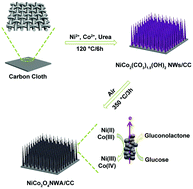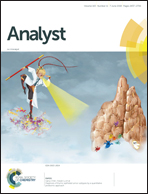Porous NiCo2O4 nanoarray-integrated binder-free 3D open electrode offers a highly efficient sensing platform for enzyme-free glucose detection
Abstract
High electrical conductivity and the exposure to more active sites are crucial to boost the performance of a glucose sensor. A porous binary metal oxide nanoarray integrated on a binder-free 3D electrode is expected to offer a highly sensitive sensing platform. As a model, porous NiCo2O4 nanowire arrays supported on carbon cloth (NiCo2O4 NWA/CC) have been prepared and used for enzyme-free glucose sensing. NiCo2O4 NWA/CC shows larger effective surface area, superior electronic conductivity, and higher catalytic activity towards enzyme-free glucose sensing, with a linear range from 1 μM to 0.63 mM, a sensitivity of 4.12 mA mM−1 cm−2, and low detection limit of 0.5 μM. Moreover, NiCo2O4 NWA/CC also displays good selectivity and stability and thus, it can be reliable for glucose detection in human serum samples. These findings inspire the fabrication of a high-performance electrochemical sensing platform by preparing porous binary metal oxide nanoarrays supported on a 3D conductive substrate.

- This article is part of the themed collection: Analyst Recent HOT articles


 Please wait while we load your content...
Please wait while we load your content...